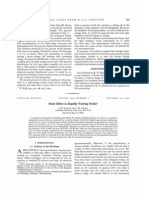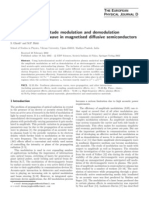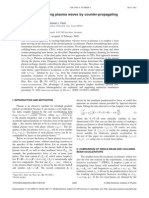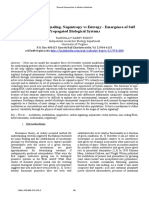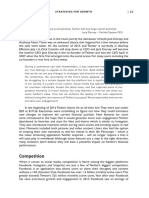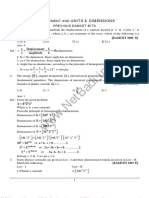tmp5F06 TMP
Uploaded by
Frontierstmp5F06 TMP
Uploaded by
FrontiersRAPID COMMUNICATIONS
PHYSICAL REVIEW B 68, 241307R 2003
Ultrafast polarization dynamics in biased quantum wells under strong femtosecond
optical excitation
D. Turchinovich and P. Uhd Jepsen
Department of Molecular and Optical Physics, Physikalisches Institut, Universitat Freiburg, Hermann-Herder-Strasse 3, 79104 Freiburg,
Germany
B. S. Monozon
Department of Physics, State Marine Technical University, Lotsmanskaya 3, 190008 St. Petersburg, Russia
M. Koch
Institut fur Hochfrequenztechnik, Technische Universitat Braunschweig, Schleinitzstrasse 22, 38106 Braunschweig, Germany
S. Lahmann, U. Rossow, and A. Hangleiter
Institut fur Technische Physik, Technische Universitat Braunschweig, Mendelssohnstrasse 2, 38106 Braunschweig, Germany
Received 1 August 2003; revised manuscript received 16 September 2003; published 22 December 2003
We observe ultrafast polarization dynamics in strongly internally biased InGaN/GaN multiple quantum wells
during intense femtosecond optical excitation. In the case of strong enough excitation we demonstrate that the
built-in bias field on the order of MV/cm can be completely screened by the carriers excited in spatially
separated states. The removal of the initial strong bias leads to dynamical modification of the band structure,
the electron and hole wave functions, and the absorption coefficient within the duration of the excitation pulse.
We show that such an optically induced dynamical screening of the biased quantum well can be described in
terms of discharging of a nanoscale capacitor driven by a femtosecond laser pulse. The electrostatic energy
stored in the capacitor is released via THz emission. Due to its nonlinearity such a process may lead to
emission of a THz pulse with bandwidth significantly exceeding that of the excitation pulse.
DOI: 10.1103/PhysRevB.68.241307
PACS numbers: 73.63.Hs, 72.20.Ht, 78.67.De
In recent years a variety of methods have been developed
to generate broadband THz pulses with femtosecond laser
pulses. Time- and field-resolved detection of such THz
pulses has been used to investigate various physical mechanisms which give rise to THz emission.1 4
Here we describe the polarization dynamics in a quantumsized structure in a strong electric field of several MV/cm,
driven by intense femtosecond fs excitation with fluences
of the order of mJ/cm2 . The choice of this regime generalizes
results from earlier studies of polarization dynamics in externally biased quantum wells QWs under weak fs excitation,
where effects caused by the electric field created by excited
carriers were negligible,1 and studies of carrier dynamics in
strongly biased p-i-n structures, where quantum confinement
played no role due to the large dimensions of the devices.4
In a biased QW the electron-hole pairs are created in polarized states. The electric field of such an optically created
dipole has a polarity opposite to that of the bias field. This
leads to a partial screening of the initial bias field, and therefore to partial removal of the initial bias. At strong and fast
enough excitation it is possible to screen the bias field completely since enough polarized electron-hole pairs can be created in a time interval much shorter than their typical recombination time. Driven by a fs laser pulse, the excitation of
polarized electron-hole pairs and the screening of the initial
bias field results in an ultrafast polarization change within
the excitation pulse duration, leading to THz emission see,
e.g., Ref. 1.
Screening of a biased QW driven by a short laser pulse is
a strongly nonlinear process. Once the first photons of the
0163-1829/2003/6824/2413074/$20.00
leading edge of the excitation pulse are absorbed the bias
field is partially screened. Consequently, the overlap of the
electron and hole wave functions and therefore also the absorption coefficient increase for the next photons to come.
Hence, the absorption coefficient and therefore the resulting
partial screening of the QW will at any time depend completely on the screening action of all photons that were absorbed previously.
To study the above effects we have chosen low-pressure
metalorganic vapor phase epitaxy grown InGaN/GaN QWs
for their large built-in electric fields. Our samples consist of
ten identical In0.2Ga0.8N QWs separated by 7.2-nm GaN barriers, and a 2- m-thick near-intrinsic GaN buffer layer. We
studied two different samples with QW widths L z of 2.7 and
3.6 nm, respectively, with a built-in field strength of 3.1 MV/
cm, directed against the growth direction.5,6 The electric
fields in the inner and outer barriers are weaker, and have a
polarity opposite to the field inside the QWs.
We use the frequency doubled output from a Ti:sapphirebased regenerative amplifier system Clark MXR, CPA 1000
with photon energy of 3.1 eV 400 nm wavelength, a pulse
duration of 120 fs, a repetition rate 1 kHz, and a fluence of
up to 1.3 mJ/cm2 . The laser beam spot area at the sample is
about 31.5 mm2 . The photon energy of 3.1 eV is enough
to excite electron-hole pairs in our QWs both in the biased
and in the completely screened cases see Fig. 1a, but not
in the barriers. The emitted THz pulses are detected by freespace electro-optic sampling in a 1-mm-thick ZnTe crystal.7
The detector bandwidth is restricted to the range 0.13 THz
due to THz absorption and phase-mismatch effects.8
68 241307-1
2003 The American Physical Society
RAPID COMMUNICATIONS
PHYSICAL REVIEW B 68, 241307R 2003
D. TURCHINOVICH et al.
FIG. 1. a Excitation of polarized and unpolarized electron-hole
pairs in biased and screened QW, respectively. b Sample and polarization geometry. P(t)transient polarization, P x and P z are its
components perpendicular and parallel to the THz propagation axis,
respectively.
Simultaneously with the THz pulse detection we measure
the time-integrated photoluminescence PL spectra from our
samples using a fiber-coupled spectrometer Ocean Optics
S2000. All the measurements are performed at room temperature.
Our excitation geometry is illustrated in Fig. 1b. The
built-in field is perpendicular to the sample surface. To obtain a nonzero projection P x of the transient dipole vector in
the direction orthogonal to the propagation direction of the
THz pulse we tilt the sample to an angle in of 45. Figure
2a shows THz pulses generated in the sample with L z
2.7 nm with an excitation fluence ranging from 0.02 to
1.3 mJ/cm2 . The shape of the THz pulses is identical for all
excitation intensities and is determined by the limited band-
FIG. 2. a THz pulses detected from a sample with L z
2.7 nm at excitation fluences 0.02, 0.04, 0.11, 0.22, 0.43, 0.65,
0.87, 1.09, and 1.26 mJ/cm2 . b Dependency of peak-peak electricfield strength of THz pulses on excitation fluence for the samples
with L z 2.7 and 3.6 nm.
FIG. 3. a Time-integrated PL spectra detected from a sample
with L z 2.7 nm at excitation fluences 0.02, 0.04, 0.11, 0.22, 0.43,
0.65, 0.87, 1.09, and 1.26 mJ/cm2 . b Dependency of PL maximum on excitation fluence for the samples with L z 2.7 and 3.6
nm. Lines are guides to the eye.
width of our setup. Since the detected pulse shape remains
unchanged at all excitation fluences, the square of the peak
field strength is proportional to the total pulse energy.
In Fig. 2b the dependency of the peak-peak amplitudes
on the excitation fluence for the pulses generated in the two
samples is shown. Initially the pulse amplitudes grow rapidly
with the optical intensity. This initial rise is followed by a
saturation for fluences higher than 0.5 mJ/cm2 . The sample
with wider QWs produces stronger pulses. When in is reversed to 45, thereby reversing the sign of P x , the THz
pulses also change their polarity. When the samples are excited at normal incidence no THz emission is detected. Both
these observations show that the THz emission is related
exclusively to the built-in bias field directed perpendicular to
the sample surface.
In Fig. 3a the time-integrated PL spectra for the sample
with L z 2.7 nm at excitation fluences in the range
0.021.3 mJ/cm2 are shown. At weak excitation a broad line
is observed with its maximum at a wavelength of 540 nm.
With increasing excitation fluence we observe a broadening
of this line to shorter wavelengths as well as a growth in
amplitude. Above a certain excitation fluence a strong and
narrow blue-shifted line appears. This line moves to 435 nm
and remains at this spectral position with further increase in
excitation fluence. We attribute the PL at weak excitation to
recombination in the biased QW both because of its spectral
position and its weak intensity. The blue-shifted line appearing at higher fluences is attributed to recombination in the
partially or completely screened QW. The fact that the PL
peak does not shift to shorter wavelength than 435 nm with
further increase in excitation fluence indicates that complete
screening of the QW is reached within our excitation fluence
range. The PL spectrum at strong excitation fluence is a superposition of optical transitions in a continuous range of
electric fields from zero, when the QW is screened to its
maximum value of 3.1 MV/cm, when all the carriers have
recombined. The spectral positions of transitions in both the
241307-2
RAPID COMMUNICATIONS
PHYSICAL REVIEW B 68, 241307R 2003
ULTRAFAST POLARIZATION DYNAMICS IN BIASED . . .
completely screened and completely biased QW are in agreement with band-structure simulations.6 The spectral position
of the blue-shifted line as function of excitation fluence for
the two samples is shown in Fig. 3b. This blue shift was
also observed in similar samples with increase in excitation
fluence in the cw regime.9
The results of both THz and PL measurements lead us to
the conclusion that the polarization dynamics in our samples
is related to the dynamical removal of the bias by the excited
polarized electron-hole pairs.
The saturation of the THz pulse amplitude with increasing
excitation fluence can be understood intuitively if we consider the QW structure as a nanoscale capacitor.
Although the energy released with the THz pulse ultimately originates from the incoming laser pulse,10 the energy
transfer from the excitation pulse to the THz pulse is mediated by the partial or complete discharge of the nanocapacitor. Therefore the maximum THz pulse energy is limited by
the electrostatic energy stored in the nanocapacitor.
The energy in the capacitor is U 21 0 AdF 2 , where 0
is the static permittivity, A is the area, d is the effective width
of the capacitor, and F is the electric field inside the capacitor. The stored energy is hence directly proportional to the
width d, determined by the initial displacement of the electron and hole wave functions rather than simply the QW
width. The initial distance between the mean weighted
maxima of the electron and hole wave functions for the
wider well is larger than for the narrow one, and thus more
electrostatic energy is stored in the wider well. For our
sample with L z 3.6 nm we estimate the stored electrostatic
energy density to be 0.5 J/cm2 . This is consistent with
the total energy of the strongest THz pulse detected in our
experiments. According to the nanoscale capacitor model the
THz pulse energy and therefore electric-field amplitude
should saturate as the total stored electrostatic energy is released. Experimentally we do not observe a full saturation
behavior, most probably due to the Gaussian profile of the
excitation beam which will always leave underscreened areas
at the edges of the excitation spot given the large dimensions
of the excitation spot
The screening of the biased QW with a laser pulse is
expected to be a strongly nonlinear process. We performed a
simulation of the wave-function and band-structure dynamics in our samples, subject to intense fs excitation. We applied an infinite QW variational approach by Bastard et al.11
in order to provide the continuity of results in strong, medium, weak, and zero electric-field regimes. In order to account for finite barriers we introduced modified effective
masses.12 Relevant material parameters were taken from the
literature.9,13,14 Our simulations only consider the ground
states for electrons and holes in the QW. Taking the excited
states into account will not change the results qualitatively.
The details of our theoretical approach will be published
elsewhere.15
In Fig. 4a the dynamics of the empty wave functions,
i.e., the wave functions representing states to be filled by the
carriers created by the next excitation photons, is shown for
the sample with L z 2.7 nm. For excitation we assume a 120
fs pulse with a wavelength of 400 nm and a fluence of
FIG. 4. a Temporal evolution of the empty wave functions
e,h for electrons and holes during the strong pulsed excitation. b
Evolution of incident photon flux dashed line, resulting electric
field in the QW dash-dotted line, and electron-hole pair-creation
rate solid line during the strong pulsed excitation.
0.7 mJ/cm2 . At negative times the wave functions are
strongly separated as a result of the strong initial bias. The
displacement of the hole wave function is larger than that of
the electron wave function due to the larger effective mass of
the hole. As the time approaches zero, the wave functions
move towards the middle of the QW, as a result of screening
of the built-in field by the previously created carriers. At
positive times the empty wave functions are located at the
middle of the QW since the bias has been removed. The
electron-hole pairs are excited in nonpolarized states and the
nanocapacitor is discharged. Subsequent recharging of the
nanocapacitor is completed when all electron-hole pairs in
the QW have recombined, and the original bias field is restored.
In Fig. 4b the temporal evolution of the electric field in
the QW and the electron-hole pair-creation rate is shown
together with the excitation pulse profile. Absorption in a
241307-3
RAPID COMMUNICATIONS
PHYSICAL REVIEW B 68, 241307R 2003
D. TURCHINOVICH et al.
biased QW can be approximated as (t) max M 2 (t),
where max is the absorption coefficient of bulk material at
comparable excitation conditions and M (t) is the timedependent overlap integral of the electron and hole wave
functions. Thus the absorption coefficient is a dynamical parameter, which depends on the band structure of the sample
at each given moment in time. In a biased QW the overlap
between the electron and hole wave functions is small, and
therefore the absorption is weak. As the QW is screened, the
absorption coefficient increases. The maximum of the
electron-hole pair-creation rate will always be at t0 since
the product of the absorption coefficient and the laser intensity always finds its maximum at t0. This nonlinear ab-
P.C.M. Planken, M.C. Nuss, W.H. Knox, D.A.B. Miller, and K.W.
Goossen, Appl. Phys. Lett. 61, 2009 1992.
2
H.G. Roskos, M.C. Nuss, J. Shah, K. Leo, D.A.B. Miller, A.M.
Fox, S. Schmitt-Rink, and K. Kohler, Phys. Rev. Lett. 68, 2216
1992.
3
Y. Hokomoto, Y. Kadoya, and M. Yamanishi, Appl. Phys. Lett.
74, 3839 1999.
4
A. Leitenstorfer, S. Hunsche, J. Shah, M.C. Nuss, and W.H.
Knox, Phys. Rev. Lett. 82, 5140 1999.
5
J.S. Im, H. Kollmer, J. Off, F. Scholz, and A. Hangleiter, Mater.
Sci. Eng., B 59, 315 1999.
6
A. Hangleiter, F. Hitzel, S. Lahmann, and U. Rossow, Appl. Phys.
Lett. 83, 1169 2003.
7
Q. Wu and X.-C. Zhang, Appl. Phys. Lett. 68, 1604 1996.
sorption can lead to the total screening of the QW within a
fraction of the excitation pulse duration. This leads to the
interesting prediction that the bandwidth of the emitted THz
pulse may significantly exceed that of the excitation pulse.
However, using identical laser pulses for both generation of
the THz pulses and subsequent sampling of their temporal
shape will not allow experimental verification of this effect.
An experiment tailored to detect the high bandwidth based
on a long excitation pulse and a short sampling pulse will
allow us to verify this effect.
D.T. and P.U.J. acknowledge stimulating discussions with
Hanspeter Helm and financial support from DFG Grant No.
SFB 276 TP C14.
M. Schall and P. Uhd Jepsen, Appl. Phys. Lett. 77, 2801 2000.
T. Takeuchi, S. Sota, M. Katsuragawa, M. Komori, H. Takeuchi,
H. Amano, and I. Akasaki, Jpn. J. Appl. Phys., Part 2 36, L382
1997.
10
A. Shimizu and M. Yamanishi, Phys. Rev. Lett. 72, 3343 1994.
11
G. Bastard, E.E. Mendez, L.L. Chang, and L. Esaki, Phys. Rev. B
28, 3241 1983.
12
C. Giner and J. Gondar, Physica B 138, 287 1986.
13
J. Wagner, H. Obloh, M. Kunzer, M. Maier, K. Kohler, and B.
Johs, J. Appl. Phys. 76, 291 2000.
14
J.S. Im, A. Moritz, F. Steuber, V. Harle, F. Scholz, and A. Hangleiter, Appl. Phys. Lett. 70, 631 1997.
15
D. Turchinovich and B. S. Monozon unpublished.
8
9
241307-4
You might also like
- Princeton Plasma Physics Laboratory: Pppl-4487 4487No ratings yetPrinceton Plasma Physics Laboratory: Pppl-4487 448738 pages
- Leemans - Observation of Terahertz Emission Froma Laser-Plasma Accelerated Electron Bunch Crossing A Plasma-Vacuum BoundaryNo ratings yetLeemans - Observation of Terahertz Emission Froma Laser-Plasma Accelerated Electron Bunch Crossing A Plasma-Vacuum Boundary4 pages
- Breakdown Limits On Gigavolt-per-Meter Electron-Beam-Driven Wakefields in Dielectric StructuresNo ratings yetBreakdown Limits On Gigavolt-per-Meter Electron-Beam-Driven Wakefields in Dielectric Structures4 pages
- Nonresonant Beat-Wave Excitation of Relativistic Plasma Waves With Constant Phase Velocity For Charged-Particle AccelerationNo ratings yetNonresonant Beat-Wave Excitation of Relativistic Plasma Waves With Constant Phase Velocity For Charged-Particle Acceleration8 pages
- Wei Yu Et Al - Direct Acceleration of Solid-Density Plasma Bunch by Ultraintense LaserNo ratings yetWei Yu Et Al - Direct Acceleration of Solid-Density Plasma Bunch by Ultraintense Laser6 pages
- Acceleration of Injected Electrons in A Laser Beatwave ExperimentNo ratings yetAcceleration of Injected Electrons in A Laser Beatwave Experiment3 pages
- Elementary Solid State Physics (Ali Omar) (Z-Library) - 131-147No ratings yetElementary Solid State Physics (Ali Omar) (Z-Library) - 131-14717 pages
- Observation of Multiple Thresholds in The Cavity QED MicrolaserNo ratings yetObservation of Multiple Thresholds in The Cavity QED Microlaser4 pages
- Plasma Wakefield Generation and Electron Acceleration in A Self-Modulated Laser Wakefield Accelerator ExperimentNo ratings yetPlasma Wakefield Generation and Electron Acceleration in A Self-Modulated Laser Wakefield Accelerator Experiment11 pages
- Letter: Quasiparticle Engineering and Entanglement Propagation in A Quantum Many-Body SystemNo ratings yetLetter: Quasiparticle Engineering and Entanglement Propagation in A Quantum Many-Body System11 pages
- Temporal Evolution of Longitudinal Bunch Profile in A Laser Wakefield AcceleratorNo ratings yetTemporal Evolution of Longitudinal Bunch Profile in A Laser Wakefield Accelerator6 pages
- Photonic S Spectra Fast Light Slow Light 2007No ratings yetPhotonic S Spectra Fast Light Slow Light 20070 pages
- Atomic Line Width: 1. The Uncertainty PrincipleNo ratings yetAtomic Line Width: 1. The Uncertainty Principle5 pages
- C.-L. Chang Et Al - Production of A Monoenergetic Electron Bunch in A Self-Injected Laser-Wakefield AcceleratorNo ratings yetC.-L. Chang Et Al - Production of A Monoenergetic Electron Bunch in A Self-Injected Laser-Wakefield Accelerator10 pages
- Laser-driven electron acceleration in plasmas with few-cycle pulses 2009No ratings yetLaser-driven electron acceleration in plasmas with few-cycle pulses 20098 pages
- Roenthal-20XX-Air Hydrodynamics of the UltafastLaser Triggered Spark GapNo ratings yetRoenthal-20XX-Air Hydrodynamics of the UltafastLaser Triggered Spark Gap19 pages
- Uv-Vis: Ultraviolet-Visible SpectrophotometerNo ratings yetUv-Vis: Ultraviolet-Visible Spectrophotometer7 pages
- Transverse Waves in A Two-Dimensional Screened-Coulomb Crystal (Dusty Plasma)No ratings yetTransverse Waves in A Two-Dimensional Screened-Coulomb Crystal (Dusty Plasma)4 pages
- Polarization Dependent Sensitivity of LeNo ratings yetPolarization Dependent Sensitivity of Le8 pages
- Energy Loss of A High Charge Bunched Electron Beam in Plasma: Simulations, Scaling, and Accelerating WakefieldsNo ratings yetEnergy Loss of A High Charge Bunched Electron Beam in Plasma: Simulations, Scaling, and Accelerating Wakefields11 pages
- Electron Beam Waves in Microwave Tubes: H. A. HausNo ratings yetElectron Beam Waves in Microwave Tubes: H. A. Haus46 pages
- Philips Research Laboratories, Eindhoven, Netherlands: AnplNo ratings yetPhilips Research Laboratories, Eindhoven, Netherlands: Anpl4 pages
- Ultrarelativistic Nanoplasmonics As A New Route Towards Extreme Intensity Attosecond PulsesNo ratings yetUltrarelativistic Nanoplasmonics As A New Route Towards Extreme Intensity Attosecond Pulses15 pages
- Magnetoresistance of Carbon Nanotubes: From Molecular To Mesoscopic FingerprintsNo ratings yetMagnetoresistance of Carbon Nanotubes: From Molecular To Mesoscopic Fingerprints5 pages
- Acousto-Optic Amplitude Modulation and Demodulation of Electromagnetic Wave in Magnetised Diffusive SemiconductorsNo ratings yetAcousto-Optic Amplitude Modulation and Demodulation of Electromagnetic Wave in Magnetised Diffusive Semiconductors5 pages
- Gennady Shvets Et Al - Excitation of Accelerating Plasma Waves by Counter-Propagating Laser BeamsNo ratings yetGennady Shvets Et Al - Excitation of Accelerating Plasma Waves by Counter-Propagating Laser Beams10 pages
- Exploration of Wave Properties in Solids With UltrasoundNo ratings yetExploration of Wave Properties in Solids With Ultrasound21 pages
- A. Popp Et Al - Electron Acceleration in A Gas-Discharge CapillaryNo ratings yetA. Popp Et Al - Electron Acceleration in A Gas-Discharge Capillary4 pages
- Coreno, M 2005 - Branching Ratios in The Radiative Decay of Helium Doubly Excited StatesNo ratings yetCoreno, M 2005 - Branching Ratios in The Radiative Decay of Helium Doubly Excited States8 pages
- Pulsed-Field Gradients - Theory and Practice - Keeler, Clowes, Davis & LaueNo ratings yetPulsed-Field Gradients - Theory and Practice - Keeler, Clowes, Davis & Laue63 pages
- G. Shvets Et Al - Generation of Periodic Accelerating Structures in Plasma by Colliding Laser PulsesNo ratings yetG. Shvets Et Al - Generation of Periodic Accelerating Structures in Plasma by Colliding Laser Pulses6 pages
- A Proposal For Establishing A GravitatioNo ratings yetA Proposal For Establishing A Gravitatio16 pages
- Intensity of Electromagnetic Waves as a Function of Frequency, Source Distance and Aperture AngleFrom EverandIntensity of Electromagnetic Waves as a Function of Frequency, Source Distance and Aperture AngleNo ratings yet
- GR 9 Final Assessment Datesheet and SyllabusNo ratings yetGR 9 Final Assessment Datesheet and Syllabus7 pages
- Western Civilization 9th Edition Jackson J. Spielvogel - Read the ebook online or download it as you prefer100% (1)Western Civilization 9th Edition Jackson J. Spielvogel - Read the ebook online or download it as you prefer52 pages
- BS 476-3-1975 - Fire Test On Building Materials & Structures - Part 3 - External Fire Exposure Roof TestsNo ratings yetBS 476-3-1975 - Fire Test On Building Materials & Structures - Part 3 - External Fire Exposure Roof Tests14 pages
- 48.lamp Illumination Control System Using Sensor CircuitNo ratings yet48.lamp Illumination Control System Using Sensor Circuit4 pages
- Acinetobacter Baumannii Skin and Soft-Tissue: Infection Associated With War TraumaNo ratings yetAcinetobacter Baumannii Skin and Soft-Tissue: Infection Associated With War Trauma6 pages
- Stakeholder Analysis Matrix (3.3.2) (10.1)No ratings yetStakeholder Analysis Matrix (3.3.2) (10.1)1 page
- Since 1989 Da Milano Is An Integral Leather Brand That Manufactures and Retails High End Leather Bags and Accessories For Both Men and Women100% (1)Since 1989 Da Milano Is An Integral Leather Brand That Manufactures and Retails High End Leather Bags and Accessories For Both Men and Women21 pages
- Princeton Plasma Physics Laboratory: Pppl-4487 4487Princeton Plasma Physics Laboratory: Pppl-4487 4487
- Leemans - Observation of Terahertz Emission Froma Laser-Plasma Accelerated Electron Bunch Crossing A Plasma-Vacuum BoundaryLeemans - Observation of Terahertz Emission Froma Laser-Plasma Accelerated Electron Bunch Crossing A Plasma-Vacuum Boundary
- Breakdown Limits On Gigavolt-per-Meter Electron-Beam-Driven Wakefields in Dielectric StructuresBreakdown Limits On Gigavolt-per-Meter Electron-Beam-Driven Wakefields in Dielectric Structures
- Nonresonant Beat-Wave Excitation of Relativistic Plasma Waves With Constant Phase Velocity For Charged-Particle AccelerationNonresonant Beat-Wave Excitation of Relativistic Plasma Waves With Constant Phase Velocity For Charged-Particle Acceleration
- Wei Yu Et Al - Direct Acceleration of Solid-Density Plasma Bunch by Ultraintense LaserWei Yu Et Al - Direct Acceleration of Solid-Density Plasma Bunch by Ultraintense Laser
- Acceleration of Injected Electrons in A Laser Beatwave ExperimentAcceleration of Injected Electrons in A Laser Beatwave Experiment
- Elementary Solid State Physics (Ali Omar) (Z-Library) - 131-147Elementary Solid State Physics (Ali Omar) (Z-Library) - 131-147
- Observation of Multiple Thresholds in The Cavity QED MicrolaserObservation of Multiple Thresholds in The Cavity QED Microlaser
- Plasma Wakefield Generation and Electron Acceleration in A Self-Modulated Laser Wakefield Accelerator ExperimentPlasma Wakefield Generation and Electron Acceleration in A Self-Modulated Laser Wakefield Accelerator Experiment
- Letter: Quasiparticle Engineering and Entanglement Propagation in A Quantum Many-Body SystemLetter: Quasiparticle Engineering and Entanglement Propagation in A Quantum Many-Body System
- Temporal Evolution of Longitudinal Bunch Profile in A Laser Wakefield AcceleratorTemporal Evolution of Longitudinal Bunch Profile in A Laser Wakefield Accelerator
- C.-L. Chang Et Al - Production of A Monoenergetic Electron Bunch in A Self-Injected Laser-Wakefield AcceleratorC.-L. Chang Et Al - Production of A Monoenergetic Electron Bunch in A Self-Injected Laser-Wakefield Accelerator
- Laser-driven electron acceleration in plasmas with few-cycle pulses 2009Laser-driven electron acceleration in plasmas with few-cycle pulses 2009
- Roenthal-20XX-Air Hydrodynamics of the UltafastLaser Triggered Spark GapRoenthal-20XX-Air Hydrodynamics of the UltafastLaser Triggered Spark Gap
- Transverse Waves in A Two-Dimensional Screened-Coulomb Crystal (Dusty Plasma)Transverse Waves in A Two-Dimensional Screened-Coulomb Crystal (Dusty Plasma)
- Energy Loss of A High Charge Bunched Electron Beam in Plasma: Simulations, Scaling, and Accelerating WakefieldsEnergy Loss of A High Charge Bunched Electron Beam in Plasma: Simulations, Scaling, and Accelerating Wakefields
- Electron Beam Waves in Microwave Tubes: H. A. HausElectron Beam Waves in Microwave Tubes: H. A. Haus
- Philips Research Laboratories, Eindhoven, Netherlands: AnplPhilips Research Laboratories, Eindhoven, Netherlands: Anpl
- Ultrarelativistic Nanoplasmonics As A New Route Towards Extreme Intensity Attosecond PulsesUltrarelativistic Nanoplasmonics As A New Route Towards Extreme Intensity Attosecond Pulses
- Magnetoresistance of Carbon Nanotubes: From Molecular To Mesoscopic FingerprintsMagnetoresistance of Carbon Nanotubes: From Molecular To Mesoscopic Fingerprints
- Acousto-Optic Amplitude Modulation and Demodulation of Electromagnetic Wave in Magnetised Diffusive SemiconductorsAcousto-Optic Amplitude Modulation and Demodulation of Electromagnetic Wave in Magnetised Diffusive Semiconductors
- Gennady Shvets Et Al - Excitation of Accelerating Plasma Waves by Counter-Propagating Laser BeamsGennady Shvets Et Al - Excitation of Accelerating Plasma Waves by Counter-Propagating Laser Beams
- Exploration of Wave Properties in Solids With UltrasoundExploration of Wave Properties in Solids With Ultrasound
- A. Popp Et Al - Electron Acceleration in A Gas-Discharge CapillaryA. Popp Et Al - Electron Acceleration in A Gas-Discharge Capillary
- Coreno, M 2005 - Branching Ratios in The Radiative Decay of Helium Doubly Excited StatesCoreno, M 2005 - Branching Ratios in The Radiative Decay of Helium Doubly Excited States
- Pulsed-Field Gradients - Theory and Practice - Keeler, Clowes, Davis & LauePulsed-Field Gradients - Theory and Practice - Keeler, Clowes, Davis & Laue
- G. Shvets Et Al - Generation of Periodic Accelerating Structures in Plasma by Colliding Laser PulsesG. Shvets Et Al - Generation of Periodic Accelerating Structures in Plasma by Colliding Laser Pulses
- Intensity of Electromagnetic Waves as a Function of Frequency, Source Distance and Aperture AngleFrom EverandIntensity of Electromagnetic Waves as a Function of Frequency, Source Distance and Aperture Angle
- Western Civilization 9th Edition Jackson J. Spielvogel - Read the ebook online or download it as you preferWestern Civilization 9th Edition Jackson J. Spielvogel - Read the ebook online or download it as you prefer
- BS 476-3-1975 - Fire Test On Building Materials & Structures - Part 3 - External Fire Exposure Roof TestsBS 476-3-1975 - Fire Test On Building Materials & Structures - Part 3 - External Fire Exposure Roof Tests
- 48.lamp Illumination Control System Using Sensor Circuit48.lamp Illumination Control System Using Sensor Circuit
- Acinetobacter Baumannii Skin and Soft-Tissue: Infection Associated With War TraumaAcinetobacter Baumannii Skin and Soft-Tissue: Infection Associated With War Trauma
- Since 1989 Da Milano Is An Integral Leather Brand That Manufactures and Retails High End Leather Bags and Accessories For Both Men and WomenSince 1989 Da Milano Is An Integral Leather Brand That Manufactures and Retails High End Leather Bags and Accessories For Both Men and Women
